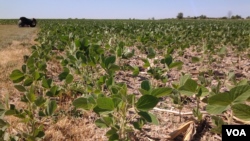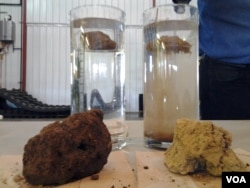Ohio — Lake Erie, the smallest of North America’s five Great Lakes, supplies fresh drinking water to an estimated 11 million people in Ohio, Michigan and southern Ontario province, Canada.
Yet sometimes pollution, both from industrial waste and farm-chemical runoff, leaves large areas of the lake covered in half-meter-thick layers of green slime. Scientists blame the excess phosphorus and nitrates entering the water, which act like fertilizer, for Lake Erie’s algal blooms.
Source of the problem
To find out where these extra nutrients come from, the Ohio Department of Natural Resources has been studying data from its network of 14 water-quality monitoring stations installed along the rivers that drain into the Lake Erie basin.
At one staton, water from the small stream is diverted into a large concrete flume where it is pumped into the testing station.
“We’ll have a sample a day, year round every day so that really pins down what the chemistry is like,” says Dave Baker of Ohio's Heidelberg University, who oversees the monitoring stations for the Department of Natural Resources.
The U.S. Environmental Protection Agency, the federal government’s pollution watchdog, requires point sources, such as factories, to monitor and report their discharges. So Baker is looking for where the other sources of pollution come from.
“If there are problems in Lake Erie, we want to know where it’s coming from and make sure we’re putting resources to remedy the problem in the right place," Baker says. "It’s stations like this that help do that.”
In this case, a primary source of the pollution turns out to be chemical fertilizer that washes off farmland during rainstorms.
No-till farming
Because farmers and ranchers believe fertilizers are essential to high crop yields, they are reluctant to stop using them.
However, the USDA’s Natural Resource Conservation Service isn’t asking them to abandon farm chemicals, but rather to use them more sparingly so they don’t run off the land when it rains. One way they can do that is to practice so-called no-till farming.
When soil is constantly pounded by the wheels of a tractor and then fluffed up with a tiller, it breaks down the natural bonds in the soil, causing it to become very hard and compact. When that happens, water or fertilizer can’t penetrate the soil, and they run off the land into local waterways and eventually into Lake Erie.
Frank Gibbs, a soil analyst with the US Department of Agriculture, explains that in no-till fields, farmers don’t break up the earth before planting and they follow the same path every time with their heavy machinery. That way, only the pathways, not the seed rows, become compacted.
“We’re using our head to farm rather than a big piece of steel," Gibbs says. "Dragging steel through the ground is not the answer, besides blowing all that diesel in the air.”
No-tilled soil results in greater water infiltration, less runoff, less erosion, and reduced flooding.
“It’s all about water quality and managing water,” says farmer Allen Dean, who has embraced no-till farming.
Yet others remain cautious about making the switch, because tilled soils can take up to five years to regain the ability to absorb and hold water. And many growers lack the specialized equipment they need for no-till farming.
Cover-crop farming
Another technique for reducing farm chemical pollution of Lake Erie is cover-crop farming. After the harvest, farmers plant a second quick-growing crop to reduce erosion. The deep-rooted plants, such as rye or turnips, help aerate the soil, allowing worms and fungi to work their magic and helping the soil to absorb more water and nutrients.
Dean says it’s discouraging that some of his neighbors don’t yet use these methods, but he notes that government programs are encouraging them to switch.
The USDA’s Environmental Quality Incentives Program has provided about $1.2 million grants to Ohio farmers to help them plant more than 10,000 hectares of cover crops. New machinery is also being developed that allows farmers to plant cover crops between rows of maturing crops.
“We want to make sure we do the best we can do and that our nutrients don’t go to the streams, and rivers and end up in Lake Erie or the Gulf of Mexico or wherever it might be,” Dean says.
By keeping their soils in good condition and reducing fertilizer runoff, Ohio farmers are not only helping themselves, but they are also reducing the threat to the region’s drinking water supply by improving the quality of water running into Lake Erie.
Yet sometimes pollution, both from industrial waste and farm-chemical runoff, leaves large areas of the lake covered in half-meter-thick layers of green slime. Scientists blame the excess phosphorus and nitrates entering the water, which act like fertilizer, for Lake Erie’s algal blooms.
Source of the problem
To find out where these extra nutrients come from, the Ohio Department of Natural Resources has been studying data from its network of 14 water-quality monitoring stations installed along the rivers that drain into the Lake Erie basin.
At one staton, water from the small stream is diverted into a large concrete flume where it is pumped into the testing station.
“We’ll have a sample a day, year round every day so that really pins down what the chemistry is like,” says Dave Baker of Ohio's Heidelberg University, who oversees the monitoring stations for the Department of Natural Resources.
The U.S. Environmental Protection Agency, the federal government’s pollution watchdog, requires point sources, such as factories, to monitor and report their discharges. So Baker is looking for where the other sources of pollution come from.
“If there are problems in Lake Erie, we want to know where it’s coming from and make sure we’re putting resources to remedy the problem in the right place," Baker says. "It’s stations like this that help do that.”
In this case, a primary source of the pollution turns out to be chemical fertilizer that washes off farmland during rainstorms.
No-till farming
Because farmers and ranchers believe fertilizers are essential to high crop yields, they are reluctant to stop using them.
However, the USDA’s Natural Resource Conservation Service isn’t asking them to abandon farm chemicals, but rather to use them more sparingly so they don’t run off the land when it rains. One way they can do that is to practice so-called no-till farming.
When soil is constantly pounded by the wheels of a tractor and then fluffed up with a tiller, it breaks down the natural bonds in the soil, causing it to become very hard and compact. When that happens, water or fertilizer can’t penetrate the soil, and they run off the land into local waterways and eventually into Lake Erie.
Frank Gibbs, a soil analyst with the US Department of Agriculture, explains that in no-till fields, farmers don’t break up the earth before planting and they follow the same path every time with their heavy machinery. That way, only the pathways, not the seed rows, become compacted.
“We’re using our head to farm rather than a big piece of steel," Gibbs says. "Dragging steel through the ground is not the answer, besides blowing all that diesel in the air.”
No-tilled soil results in greater water infiltration, less runoff, less erosion, and reduced flooding.
“It’s all about water quality and managing water,” says farmer Allen Dean, who has embraced no-till farming.
Yet others remain cautious about making the switch, because tilled soils can take up to five years to regain the ability to absorb and hold water. And many growers lack the specialized equipment they need for no-till farming.
Cover-crop farming
Another technique for reducing farm chemical pollution of Lake Erie is cover-crop farming. After the harvest, farmers plant a second quick-growing crop to reduce erosion. The deep-rooted plants, such as rye or turnips, help aerate the soil, allowing worms and fungi to work their magic and helping the soil to absorb more water and nutrients.
Dean says it’s discouraging that some of his neighbors don’t yet use these methods, but he notes that government programs are encouraging them to switch.
The USDA’s Environmental Quality Incentives Program has provided about $1.2 million grants to Ohio farmers to help them plant more than 10,000 hectares of cover crops. New machinery is also being developed that allows farmers to plant cover crops between rows of maturing crops.
“We want to make sure we do the best we can do and that our nutrients don’t go to the streams, and rivers and end up in Lake Erie or the Gulf of Mexico or wherever it might be,” Dean says.
By keeping their soils in good condition and reducing fertilizer runoff, Ohio farmers are not only helping themselves, but they are also reducing the threat to the region’s drinking water supply by improving the quality of water running into Lake Erie.








